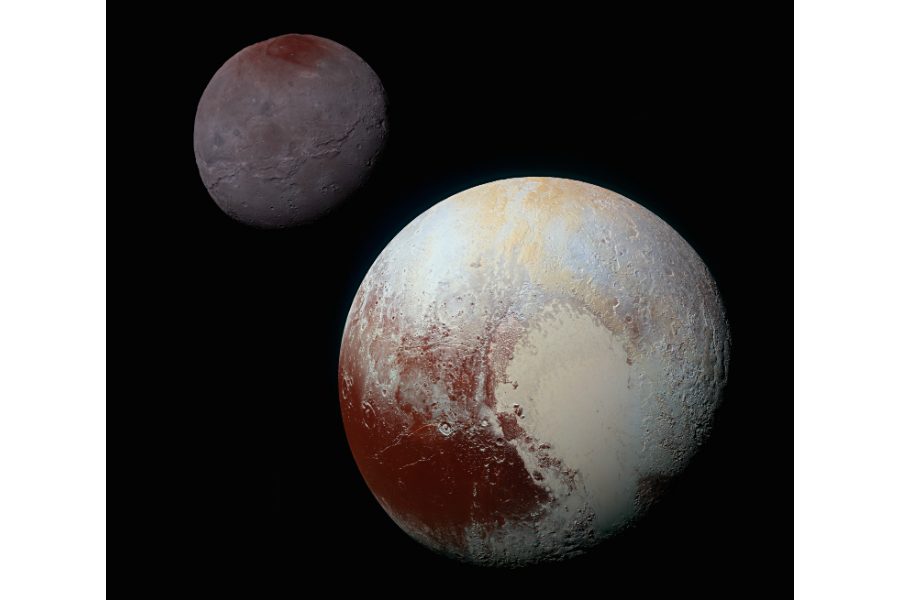Why Pluto's 'icy heart' may have sunk under its own weight
Pluto's "icy heart" rests in a depression on the surface of the dwarf planet and scientists now have a new idea how that feature formed.
The feature first captured the interest of researchers and regular people alike because of its heart shape visible in an image beamed back to Earth by NASA's New Horizons spacecraft in July 2015. Since then researchers have largely thought that the smooth western lobe of the heart, informally called Sputnik Planitia, is an impact crater that filled with the nitrogen, methane, and carbon monoxide ices that give the iconic feature its bright look.
But now scientists have proposed a less violent model for how Sputnik Planitia may have formed, in a paper published Wednesday in the journal Nature. Instead of a massive space rock slamming into the dwarf planet, the research team says the weight of ices themselves may have made Pluto's heart sink, creating the depression in which the ice now sits.
Or, as study lead author, Douglas Hamilton, a professor of astronomy at the University of Maryland, poetically described it: "Pluto’s big heart weighs heavily on the small planet, leading inevitably to depression."
Something similar happens on Earth, too, Dr. Hamilton added in a press release. The Greenland Ice Sheet has pressed down on the crust, creating a basin. Sputnik Planitia is formed by ice that is about 2.5 miles thick that sits in a depression that is about 600 miles wide.
But why did ice accumulate and press down on the dwarf planet at 30 degrees latitude and 180 degrees longitude rather than somewhere else, perhaps closer to its poles?
Pluto's unique spin axis could explain the location of its heart, Hamilton suggests. Pluto's spin axis is tilted by 120 degrees, which is extreme (Earth's tilt is 23.5 degrees). As a result, the coldest places on the dwarf planet would end up being along the 30 degrees north and south latitudes. (The center of Sputnik Planitia is at 25 degrees north latitude.)
According to Hamilton's model, as ice formed in these cold regions, it would lead to more ice formation. That's because the ice would reflect light and heat, keeping the temperature low. Eventually this positive feedback loop, called the runaway albedo effect, would make it so just one dominant ice cap exists on the dwarf planet – like Sputnik Planitia.
And, Hamilton explained to the Los Angeles Times, "On Pluto, nitrogen ice weighs more than the bedrock, which is water ice.... If you lay that much nitrogen on top of the water ice, the ices make the hole by themselves."
Hamilton's model could also help explain the location of Pluto's largest moon, Charon. Early in Pluto's existence, a humongous space rock slammed into the dwarf planet, kicking up debris and ultimately forming Charon.
The impact also would have nudged Pluto to spin rather quickly. Over time, Pluto's rotation would have slowed, eventually matching Charon's orbital rate so that the moon became tidally locked, with each planet only ever seeing one side of the other. (Picture it as if the two bodies were "joined by a rigid stick," Amy Barr of the Planetary Science Institute in Arizona writes in companion commentary published in Nature News and Views.)
And Charon happens to face the side opposite Sputnik Planitia almost squarely.
Hamilton thinks this is because the weight of the ice in Sputnik Planitia shifts the dwarf planet's center of mass so that the mass of Charon is gravitationally pulled to be on line with the mass of Sputnik Planitia. As such, Sputnik Planitia had a 50 percent chance of ending up directly facing or directly opposite the moon.
Hamilton's model is still just a computer model and other models based around the idea that the dwarf planet's icy heart sits in an impact crater were described in other papers published alongside Hamilton's in the journal Nature on Wednesday.






